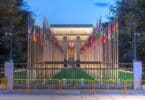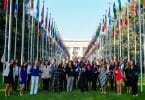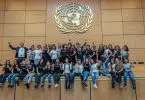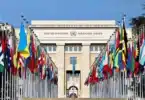Protection is commonly defined as “all activities aimed at obtaining full respect for the rights of the individual in accordance with the letter and spirit of the relevant bodies of law, namely human rights law, international humanitarian law and refugee law” (Source). Hence, it is correct to assume that protection covers all activities and projects implemented by the different agents working with refugees, and this does not only include legal protection such as provision of refugee documents, but also every day tasks such as casework and recreational activities. But let’s see first how protection of refugees came about as a concept.
In fact, protection is primarily the responsibility of states and its agents. In the case of a state or government that is unwilling or unable to protect its own citizens for any given reason, these individuals have the right to seek asylum elsewhere, which is stipulated in the 1951 Geneva Convention’s definition of a refugee. The 1951 Refugee Convention and the 1967 Protocol are at the cornerstone of the international legal framework for refugee protection as they establish the main principles on which refugee protection is based – such as the Principle of non-refoulement and the principle of Non-discrimination.
What is Legal Protection of Refugees?
Legal protection of refugees does not start when the individuals receive the legal refugee status. It starts from the moment the person arrives at the borders of the potential country of asylum. This is when we talk about the principle of non-refoulement, which stipulates that no potential asylum seeker is to be returned to their country of origin or to a third country where their lives might be in danger, and that everyone has the right to seek asylum.
The fundamental principle of non-refoulement plays a very important role in the international refugee protection system. It prohibits the return of a person (including by non-admission to the border) to a State where his life and safety might be in danger. To some degree, non-refoulement involves the admission of the person who is still an asylum seeker on the territory of the State to which he is seeking refuge. No protection can really be conceived without this territorial or geographical dimension, which gives legal protection its meaning. Non-refoulement is in a way the very foundation of the protection system. It is included in Article 33 of the Convention of 28 July 1951. If the restrictive interpretation is possible, and has even been used often, it is clear that the principle of non-refoulement must be applicable to the asylum seeker even before he receives a positive decision of eligibility. This is how it is understood by the Office of the High Commissioner.
Article 33 – Prohibition of expulsion or return (“refoulement”)
1. No Contracting State shall expel or return (” refouler “) a refugee in any manner whatsoever to the frontiers of territories where his life or freedom would be threatened on account of his race, religion, nationality, membership of a particular social group or political opinion.
Now that the individual is safe and admitted into the territory of their potential country of asylum, legal protection starts from the moment of receiving these individuals and registering them with the relevant authorities, be it the government or UNHCR in some cases. Access to registration as an asylum seeker is one of the first instruments of legal protection as it guarantees that the individual is under the responsibility of the registering authority, which means not only that they would not be returned to their country while their file is being processed but also that they are now legally staying on the territory.
Legal protection continues through the phase of Refugee Status Determination, where the relevant authority uses international refugee law instruments to decide whether or not the asylum seeker should be granted the refugee status, depending on the reasons why they left their country.
By going through status determination processes and potentially being recognized as a refugee, individuals are legally protected by being granted legal documents that are issued from their country of asylum and are valid for a certain period of time, usually not less that one year at a time. This procedure guarantees therefore the freedom of movement of refugees in the country of asylum, apart from the fact that it gives them access to any sort of social contracts, legal procedures and aspects of everyday life that the local community usually enjoys.
Physical Protection
The next type of protection is physical protection which, as the name indicates, focuses on the physical needs of refugees and asylum seekers. Physical protection covers all sorts of accommodation and sheltering to start with. Depending on the context, the situation and the country of asylum, accommodation of refugees can be done in camps, shelters, urban areas, host families…etc. The main idea is that persons of concern are safe and are accommodated in a secured place. This also encloses other sorts of physical needs like food and sanitation. In order to fulfill physical protection minimum standards, refugees need to be provided with adequate food, sanitation, hygienic products and any non-food items that are needed in a specific context or emergency.
Ongoing Protection: Case Management
Protection does not stop at the door of the refugee camp or at the legal document stamped by UNHCR. It is actually an ongoing process as we are working with extremely vulnerable people every single day. Indeed, casework is one of the most known ways of protection of refugees as case workers follow on a day-to-day basis issues of refugees and work on finding efficient solutions. This can be related to all sorts of protection issues like Gender-Based Violence, Child Protection, Health issues, education.
Durable Solutions
The refugee situation is supposedly temporary, based on the international legal framework. This means that the event that contributed to the displacement of refugees might disappear on the short or long run; and refugees would then be able to return to their country of origin. However, if this is not the case, it is likely that the refugee will have to consider his final settlement in another country and to take a new nationality, thereby ceasing to be uprooted.
One of the essential functions of UNHCR is “to seek permanent solutions to the problem of refugees, by assisting Governments and, subject to the approval of the Governments concerned, private organizations to facilitate the voluntary repatriation of such refugees, or their assimilation into new national communities” (Source).
Durable solutions aim at “empowering refugees, especially women, and strengthening their productive capacities and self-reliance” (Source).
The first of these solutions is “voluntary repatriation” in the country of origin. This implies the cessation of refugee status. It is therefore the reintegration of the individual to his home nation-state. This solution is put forward by UNHCR as the best for the refugee in the case of cessation of the reasons that led to his/her displacement in the first place.
When voluntary return is not possible, and in the case where the host country offers the possibility of “local integration”, it is therefore assimilation to the host country that is proposed, either by remaining a refugee (thus deprived of citizenship rights) or by taking the nationality of the host country. This is the second option that is being considered by UNHCR. Refugees are then caught in a legal process of granting them rights that are more and more similar to those of the nationals of the host country. Over time, this process should lead to permanent resident status and, in some cases, the nationality of the country of asylum. We should not forget, however, that access to nationality is a discretionary right of states.
The third solution is resettlement in a third country or the continuation of migration and access to citizenship in this third country. It is considered both as a last resort solution, when the other two have failed, and as a means to achieve a more equitable burden-sharing of refugees. UNHCR recommends to host countries cases that it considers to be in need of special protection.
As a conclusion, it is crucial to remember that refugee protection is a very vast field of work in which humanitarian workers can use their skills and achieve their potential by simply abiding by the 1951 Refugee Convention and all the other legal instruments used in working with refugees.












